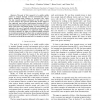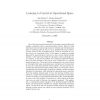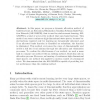20 search results - page 2 / 4 » Biological arm motion through reinforcement learning |
ICRA
2010
IEEE
13 years 3 months ago
2010
IEEE
— The goal of this research is to enable mobile robots to navigate through crowded environments such as indoor shopping malls, airports, or downtown side walks. The key research ...
ISCAS
2002
IEEE
13 years 10 months ago
2002
IEEE
We have implemented an aspect of learning and memory in the nervous system using analog electronics. Using a simple synaptic circuit we realize networks with Hebbian type adaptati...
AR
2007
13 years 5 months ago
2007
—Reinforcement learning is the scheme for unsupervised learning in which robots are expected to acquire behavior skills through self-explorations based on reward signals. There a...
IJRR
2008
13 years 5 months ago
2008
One of the most general frameworks for phrasing control problems for complex, redundant robots is operational space control. However, while this framework is of essential importan...
AUSAI
2004
Springer
13 years 10 months ago
2004
Springer
In this paper, we propose a dynamic allocation method of basis functions, an Allocation/Elimination Gaussian Softmax Basis Function Network (AE-GSBFN), that is used in reinforcemen...



